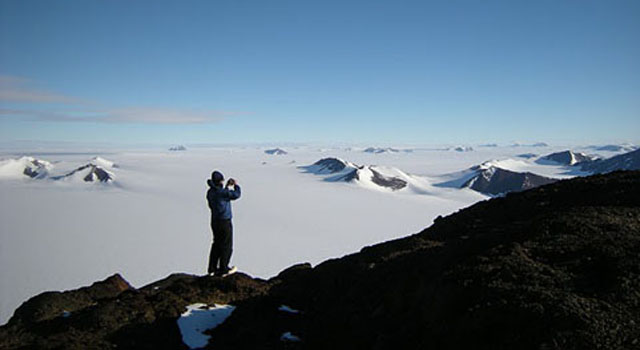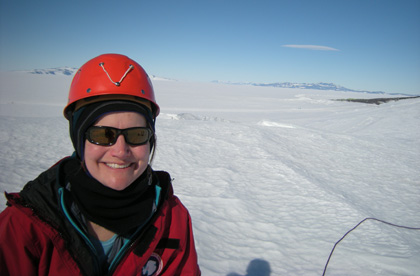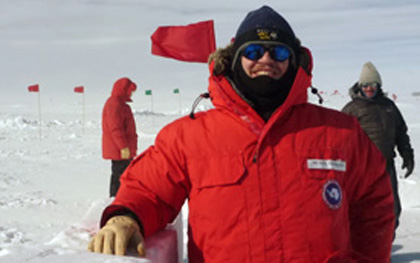 For more than a month, geosciences professor Claire Todd and her geosciences student, Michael Vermeulen ’12 lived and worked on the ice in Antarctica. (Photos by Claire Todd)
For more than a month, geosciences professor Claire Todd and her geosciences student, Michael Vermeulen ’12 lived and worked on the ice in Antarctica. (Photos by Claire Todd)
A Day in the Life of PLU’s Antarctic Geologists
“Mac Ops, Mac Ops, Mac Ops! This is India 1! 5! 6! How copy?”
These are the words that woke me and PLU geosciences student Michael Vermeulen ’12 most mornings during our geologic expedition in Antarctica this winter. All field camps participating in the U.S. Antarctic Program are required to check in with McMurdo Operations (“Mac Ops”) once a day at a previously agreed-upon time. Each field camp is associated with a project number; ours is I-156. Located 1,000 miles from McMurdo Station, our project’s camp was the most remote of the 2010-2011 field season, and it could be very difficult to reach McMurdo using our high frequency radio. The most common response to the broadcast above was:
“Field Party calling Mac Ops, you are weak and barely readable. Repeat. Weak and barely readable. How copy?”
This check-in process began all 32 days we spent in the field. Some mornings we were forced to use our satellite phone to meet our morning check-in deadline of 8 a.m. Meeting this deadline is our most important priority each morning; a missed check-in would launch an incredibly costly, continent-wide search effort within an hour of the scheduled time.

Funded by a $125,000 National Science Foundation grant, geosciences professor Claire Todd, PLU geosciences student Michael Vermeulen ’12, and four other researchers traveled to Antarctica this past winter to study deglaciation – that is, how fast ice has been melting – over the last millennia.
Once check-in was complete, breakfast could be fully under way! All cooking and eating happened in our only “indoor” communal space – the cook tent. Cooking and cleaning duties rotated between the six members of our field party. With no running water, the most important breakfast task was melting snow. The resulting boiling water would meet our coffee and oatmeal needs, as well as fill our thermoses with water to use for instant soup and tea throughout our fieldwork that day.
Depending on the mood and ambition of the breakfast cook on duty, additional tasks could include making pancakes or “cheesy-bagels,” – a field-camp delicacy – or even sausage or bacon. Well-fed and well-rested, the team would then discuss our plans for the day.
The single most important factor determining our activities each day was weather. While temperature and wind speed might affect our overall comfort, we were most concerned with visibility and surface contrast. Visibility is how far in front of us we can see. Fog and windblown snow are some of the things that can result in poor visibility. Without good visibility, we would be unable to safely operate snowmobiles or create accurate maps of the area. Surface contrast is caused by sunlight interacting with the snow surface and creating shadows; these shadows help us distinguish surface features such as depressions that may indicate subsurface crevasses, or cracks in the ice below. On overcast days, clouds block sunlight from reaching the snow surface, and there are no shadows we can use to identify features in the snow. These conditions are called “flat light,” and make it difficult and sometimes dangerous to travel over new terrain. Out of 32 days, we spent six in camp due to poor visibility and low surface contrast.
Once our plans were determined, we would pack our lunches and field gear and head off on snowmobiles to our agreed-upon work locations. Typically, we would work in two groups of three. Michael’s and my team would climb mountains rising up to 2,000 feet above the ice surface to collect samples from glacial deposits. Due to difficult travel conditions across rock and snow, most days we would walk less than five miles. The second team would spend the day on snowmobiles dragging an ice-penetrating radar system to identify features beneath the ice surface. For safety reasons, each team had adhere to the plan set up during the morning meeting, exploring only those locations discussed with the team. We would also check-in with each other at noon each day using hand-held radios or satellite phones. These precautions would allow one team to locate another in the event of an emergency.

PLU geosciences student Vermeulen ’12, along with Todd and four other researchers, traveled by C-130 cargo plane to a location in the Pensacola Mountains 1,000 miles away from McMurdo Station, the home of the U.S. Antarctic Program.
Ice sheets leave behind clues about its past, by eroding bedrock beneath them and incorporating chunks of this bedrock within the ice. These pieces of bedrock are then transported and smoothed by ice flow. When ice thins or retreats, these smoothed, transported rocks are left behind on mountainsides emerging from the thinning ice. We use these rocks to track the rate and extent of ice-sheet retreat.
While debating which rock samples we should collect and mapping past ice-flow directions, we would also have to work hard to maintain our body temperature. Adjusting clothing layers, drinking hot water, snacking and moving were the primary ways we would keep our body temperature elevated. While temperatures never dipped below zero degrees Fahrenheit, the wind could make it very difficult to stay warm.
While challenging, these work-filled days are also exhilarating. Most mornings we climbed up to a summit over new terrain, noting new rock types and adding glacial geologic clues to our understanding of the ice sheet’s past. Reaching the summit would mark the midpoint of our day, and would provide spectacular 360-degree views of mountain ranges flooded by ice. Days without wind would offer utterly noiseless conditions, which we happily filled with hypotheses of past ice sheet elevations and flow directions, and more philosophical musings about finding ourselves on such a beautiful and remote mountain top.
After about eight hours of field work, we would typically return to camp around 5 or 6 p.m. with a new pile of up to 10 rocks in tow. The snowmobile trip back home was often the coldest time of day for us; it is especially hard to stay warm when you’re sitting still. One evening I returned to camp with eight layers on, and I was still fighting to stay warm.
As in the morning, the first order of business upon returning to camp is providing hot water. The team member on dinner duty would begin by cranking up our cook stoves and melting snow. We would all meet in the cook tent, snack on crackers and cheese, and share our stories from the day. Our dinners were luxurious! We had an incredibly well-stocked freezer, a 1-meter-deep pit dug in the snow outside of the cook tent. Main dinner courses included salmon and halibut fillets, and shrimp. For side dishes, we had a long list of frozen vegetables to choose from, as well as choices of rice, pasta, couscous, tortillas, pita bread, and even quinoa! Aside from the bustle of meal preparation, the cook tent was never quiet, and most commonly filled with laughter. Conversation would wander from scientific topics to story-swapping, to books we’re reading, to singing favorite songs, to post-field-season plans and beyond. The only six people within hundreds of miles, we were not only work colleagues, but also each other’s friends and family.
Finally, we would say our good nights and head to our tents for a much-needed night’s sleep. Even with the 24-hour daylight of the Antarctic summer, we rarely had trouble falling asleep. Several hours later, we would begin a new day’s work.


